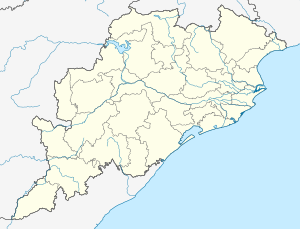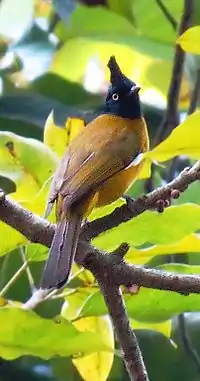Kuldiha Wildlife Sanctuary
The Kuldiha Wildlife Sanctuary (Odia: କୁଲଡିହା ବନ୍ୟଜନ୍ତୁ ସଂରକ୍ଷଣାଳୟ) is situated in the Balasore district of Odisha, India. The sanctuary is spread across 272.75 km2 (105 sq mi) in the Chota Nagpur Plateau region. It is linked with Simlipal National Park via the Sukhupada and Nato hill ranges. It is classified as an Eastern Highlands moist deciduous forests ecoregion.
| Kuldiha Wildlife Sanctuary | |
|---|---|
| କୁଲଡିହା ବନ୍ୟଜନ୍ତୁ ସଂରକ୍ଷଣାଳୟ | |
IUCN category IV (habitat/species management area) | |
 Location of Kuldiha Wildlife Sanctuary in Odisha | |
| Nearest city | Balasore |
| Coordinates | 21.20°N 86.3°E |
| Area | 272.75 km2 (105.31 sq mi) |
| Designated | January 4, 1984 |
| Visitors | 6340 (in 2015)[1] |
| Governing body | Ministry of Forest and Environment, Government of Odisha |
| Website | http://www.kuldihatourism.com/ |
About
It was declared a sanctuary on 4 January 1984.[2] It is famous for the Mayurbhanj Elephant Reserve that spreads across Simlipal, Kuldiha and Hadgarh wildlife reserves.[3] Locally in Kuldiha, the elephant reserve is known as Tenda Elephant Reserve.[4][5] There is a watch tower strategically created at Garsimulia for animal lovers to have a look at elephants bathing or drinking water from a small stream that runs right through the reserve.[6] The sanctuary offers night stay accommodation at Kuldiha entrance, Jadachua and Rishia in form of huts, tents and a few concrete houses. Prior reservation is required for night stay.[7] It is usually closed during the peak monsoon season which typically falls between July and September.[1] Major fire was reported in 2012 that engulfed both Simlipal and Kuldiha forests causing significant damage to flora and fauna.[8] The sanctuary has been declared an ecological sensitive zone as of August 2, 2013 by the government.[9]
Tourism
Kuldiha is an integral part of tourism in northern Odisha, attracting tourists and scholars alike.
Ecotourism
Odisha’s government took recognition of the environmental damage being done by private operators to many parks, sanctuaries and reserves resulting in a sustainable threat to biodiversity. It came up with an ecotourism focus to conserve the pristine state of nature while making it economically viable with a PPP model. Kuldiha sanctuary is operated in a community based ecotourism model that benefits locals and tribesmen inhabiting the core area of the sanctuary.[7][10][11][12]
Access
The sanctuary is almost equidistant from Bhubaneswar and Kolkata. It is easier to reach from Bhubaneswar, being the capital city of Odisha state. The nearest airport is Biju Patnaik International Airport. The nearest railway station is Balasore railway station. One can take NH16 (earlier designated NH5) and reach Nilagiri via State Highway 19; thereafter a scenic narrow road leads to the sanctuary entrance.
Flora and fauna

It is a mixed deciduous forest dominated by the Sal tree. Various animals inhabit the forest, including Tiger, Leopard, Elephant, Gaur, Sambar, Giant Squirrel, Hill Myna, Peafowl, Hornbills, other migratory birds and reptiles .[13][14][15] A comprehensive scientific report on the animal species present in the park is available in this survey:ISSN 2449-8866.[16] The sanctuary is a haven for environmental and animal research. There are numerous scientific surveys and reports available that focus on the study of flora and fauna of the sanctuary.[17][18][19]
See also
References
- "Kuldiha Sanctuary Closed". The New Indian Express. 16 June 2015.
- Ramakrishna; Zoological Survey of India (2006). Faunal resources of Similipal Biosphere Reserve, Mayurbhanj, Orissa. Kolkata: Zoological Survey of India. p. 3. ISBN 8181711149.
- "Mayurbhanj Elephant Reserve". www.simlipal.org. Retrieved 27 May 2016.
- "Kuldiha Forest, Balasore – 350 kms [sic] from Kolkata".
- Sharma, R P. The Indian Forester (Volume 122) (1996 ed.). University of Minnesota. pp. 927–931.
- "Kuldiha- A less known Forest". 6 September 2009.
- Udgata, Harsha Bardhan (November 2012). "Eco-Tourism Destinations of Odisha" (PDF). Government of Odisha. p. 49.
- "Forest fire engulfs Similipal, Kuldiha areas". news18. 8 March 2012.
- "Submission of proposals to the States for declaration of Eco-sensitive Zones." (PDF). Ministry of Environment and Forests (India). 2 August 2013. p. 3.
- Raghu Prasad, R. "ECOTOURISM AND PROTECTED AREAS: CONTRIBUTING COMMUNITY DEVELOPMENT AND CONSERVING BIODIVERSITY, PILOTED IN SATKOSIA" (PDF). TERI University. Retrieved 30 May 2016.
- "ECOTOURISM IN ODISHA". www.odishaecotourism.com. Retrieved 30 May 2016.
- Barik, Bibhuti (June 2015). "Private push to eco-tourism". The Telegraph (Calcutta).
- Murmu, Atindra; Mazumdar, P.C.; India, S. Chaudhuri ; edited by the Director, Zoological Survey of (2013). Mammal and avi-fauna of Kuldiha Wildlife Sanctuary, Orissa. Kolkata: Zoological Survey of India. ISBN 978-8181713414.
- Negi, S.S. (2002). Handbook of national parks, wildlife sanctuaries, and biosphere reserves in India (3rd rev. ed.). New Delhi: Indus Pub. Co. p. 145. ISBN 8173871280.
- "Winged Visitors Find New Winter Homes". The New Indian Express. 11 January 2014.
- Rout, Srustidhar; et al. (27 December 2015). "Diversity of herpetofaunal community in Kuldiha wildlife sanctuary, Odisha, India". Current Life Sciences. 2016 2(1) (9–14). ISSN 2449-8866.
- "Food and Feeding habits of Indian Bison, Bos Gaurus (Smith, 1827) in Kuldiha Wildlife Sanctuary, Balasore, Odisha, India and its Conservation". International Research Journal of Biological Sciences. 4 (5): 73–79. 8 May 2015. ISSN 2278-3202.
- Mohapatra, KK; Patra, AK; Paramanik, DS (January 2013). "Food and feeding behaviour of Asiatic elephant (Elephas maximus Linn.) in Kuldiha Wild Life Sanctuary, Odisha, India". Journal of Environmental Biology. 34 (1): 87–92. PMID 24006812.
- Hemanta K Sahu; Harsha B Udgata; Subrat Debata; Himanshu S Palei (2014). Vertebrate Fauna of Kuldiha Wildlife Sanctuary. Mumbai: Himalaya Publishing House. p. 128. ISBN 9789351427308. Retrieved 30 May 2016.
Notes
Approval from Himalaya Publishing House to use their academic report uploaded herewith for future reference.![]()